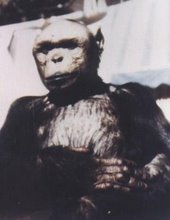
"Nobody celebrates at Jack in the Box."
Last night Heather & I made our first trip to L.A. since we moved to San Diego. We went to the Hammer Museum, home of the Billy Wilder Theater, to see the great Jamaa Fanaka's 1976 masterpiece, "Emma Mae." It was my second time seeing it in a theater, plus it was a brand new 35mm print, presumably cut for a new DVD release in the near future (hopefully under it's original title). Heather had never seen it, but neither of us are strangers to the wondrous Mr. Fanaka. He's a born entertainer, and his Q&A's are really something special.

Like I said, I've seen "Emma Mae" once before in the theater, as well as "Welcome Home Brother Charles," "Penitentiary," & "Penitentiary 3;" all of which featured Mr. Fanaka in person, but this screening was extra special because not only was he present, but so were many of the cast members (Charles D. Brooks III & Synthia James), including Emma Mae herself, actress Jerri Hayes.

"Emma Mae" is a "moving picture," as Mr. Fanaka says, that has held up very well over time. Contrary to what the home video title, "Black Sister's Revenge," might suggest, "Emma Mae" is not your typical Blaxploitation Revenge film. From the beats and rhythms of the opening scene which captures a real life community spending the day at the park, the film feels different. It's clear in the opening minutes that Mr. Fanaka is a man who realizes the power of his camera, and that he has something to say.

An important component to fully appreciating the work of Fanaka is understanding how his early films were made. He is the only student of the prestigious UCLA film program to have no less than 3 features made and distributed while attending the University. While having access to UCLA's equipment, it is important to recognize what "Emma Mae" truly is, an ambiguous Independent film. In the same way he gained access to an abandoned jail house and masked a UCLA parking lot as a prison courtyard for "Penitentiary," Fanaka makes the most of every local he can for "Emma Mae."

The story of "Emma Mae" is that of a young naive girl from Mississippi (home of Mr. Fanaka) who moves to Southern California to be with her Uncle's family after her Mother passes away. In what was described at the screening as a "migration story," "Emma Mae" is about the difficult adjustment Emma must make to her new surroundings, combating others expectations of her, and to some extent, the equality of the sexes. Upon arriving by bus, Emma is quickly introduced to her cousins' world of friends, including Jesse & Zeke, a lanky, charming drug addict and his somewhat goofy partner.
 (Left: Big Daddy, Zeke pictured on the right in the stylish hat)
(Left: Big Daddy, Zeke pictured on the right in the stylish hat)When Jesse and Zeke find themselves wanted by the law, enamoured Emma holds up with them in the house of Big Daddy Johnson, a character similar to 'Seldom Seen' Jackson in "Penitentiary," who imparts a sort of elder wisdom to the youth of the film. When the cops imprison Jesse and Zeke, Emma does her best to lead a communal effort to save them. She literally fights, hustles, and robs to raise the money to get Jesse back. When he is finally released his true colors are revealed and he finds out that Emma is more than he ever imagined.

This screening was very special for many of the folks on stage, some of which, like Miss Jerri Hayes, had not scene the film on the big screen in over 30 years. After the movie, Hayes commented that it was better than she remembered, a common reaction to one's own work. Some time removed always softens one's self-criticism. I also spoke to Mr. Fanaka after the screening and he was ,as usual, a pleasure. It was nice seeing "Emma Mae" in an academic setting, in the same way it was nice to see it recognized by Turner Classic Movies a while back.
Jamaa Fanaka is an unsung auteur of Exploitation Cinema who continues to be rediscovered and appreciated everyday. "Emma Mae" is his crowning achievement.
Heather had her picture taken with Billy Wilder.

And I had mine taken with "Emma Mae."

--Popkoff
"Emma Mae" screened at the UCLA Hammer Museum on Dec. 16th, 2011 as part of the L.A. Rebellion: Creating a New Black Cinema - Film Series.

2 comments:
WOW! she still looks great. wish she'd did more films & t.v...emma mae aka black sisters revenge, is still 1 of my favs.
I would love to meet Emma Mae she was special Melvin thomas I’m watching it as we speak for the 3rd time thanx
Post a Comment